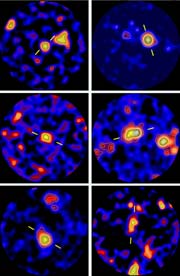

Revealing images produced by one of the world’s most sophisticated telescopes are enabling a team of Edinburgh astronomers to see clearly for the first time how distant galaxies were formed 12 billion years ago. Scientists from the UK Astronomy Technology Centre (UK ATC) and the University of Edinburgh have been targeting the biggest and most distant galaxies in the Universe with the world’s most sensitive submillimetre camera, SCUBA. The camera, built in Edinburgh, is operated on the James Clerk Maxwell Telescope in Hawaii. The images, published in Nature tomorrow (18 September), reveal prodigious amounts of dust-enshrouded star formation which could ultimately tell scientists more about the formation of our own galaxy.
It is thought these distant galaxies in the early Universe will evolve into the most massive elliptical galaxies seen at the present day. These giant galaxies consist of 1000 billion stars like our Sun and are found in large groups or clusters.
Dr Jason Stevens, astronomer at the UK ATC in Edinburgh explained why understanding the evolution of these galaxies is so important. “The distant, youthful Universe was a very different place to the one we inhabit today. Billions of years ago, massive galaxies are thought to have formed in spectacular bursts of star formation. These massive elliptical galaxies have relatively simple properties. We hope that by understanding how simple galaxies form we will be one step closer to understanding how our own, spiral, Milky Way galaxy formed”.
Prof. Jim Dunlop, Head of the University of Edinburgh’s Institute for Astronomy said: “For a long time astronomers have anticipated that the formation of the most massive galaxies should have been a spectacular event, but failed to find any observational evidence of massive galaxy formation from optical images. Now we have discovered that it is indeed spectacular, but because of the effects of interstellar dust, the spectacle is only revealed at submillimetre wavelengths.” The dust absorbs the bright blue light emitted by young stars. The energy from the light heats the dust and makes it glow. It is this glow that is detected by the SCUBA camera.
Dr Stevens and his colleagues suspected that these massive galaxies would form in particularly dense regions of space so they chose regions of very distant space that are known to be very dense because they contain massive radio galaxies – galaxies which emit high levels of radio waves. They found that many of the radio galaxies have near-by companion objects that had not previously been detected at any wavelength. Dr Rob Ivison, also at the UK ATC, described what they found. “The companion objects are located in the densest parts of the intergalactic medium, strung out like beads of water on a spider’s web due to the filamentary structure of the Universe”.
The SCUBA images support a popular current model of galaxy formation in which today’s massive elliptical galaxies were assembled in the early Universe in dense regions of space through the rapid merging of smaller building blocks.












